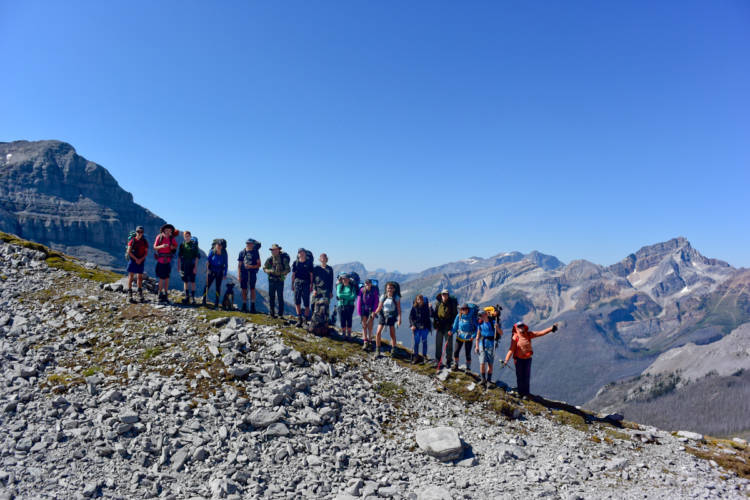Height of the Rockies, Akamina-Kishinena, Gilnockie, Kianuko, Lockhart Creek, the upper Cummins Valley and the Purcell Wilderness Conservancy, Elk Lakes and Bugaboos expansions: some of the area’s most beautiful and biodiverse landscapes were protected as provincial parks through the CORE process in the mid-90s. It was on this day, July 12th, 22 years ago that six new parks and park expansions were established in the East Kootenay. Wildsight—then the East Kootenay Environmental Society—was one of the key drivers behind these newly protected landscapes.
I often find myself referring to the CORE process in discussions and am usually met with a blank look. The CORE process—the Commission on Resources and the Environment—was a multi-year land-use planning process that brought together industry, hunters, anglers, recreationists and communities to discuss and negotiate land-use designations. Four regions had land-use tables, including the East and West Kootenays. CORE is a key part of our Kootenay history and a key part of Wildsight’s history, as we look back on 30 years of protecting wild places.
Before CORE, 13% of the East Kootenay was protected as parks. After CORE, 16.5% of the East Kootenay was protected, with the addition of 7 new protected areas, 2 new wildlife management areas, and 11% of the region was placed in new special management zones to give some extra protection to sensitive areas.
John Bergenske, Ellen Zimmerman, Leslie Giroday and Kent Goodwin represented the environment at both north and south East Kootenay land-use tables, speaking up for biodiversity, nature and sustainable communities. Many others supported the work of these volunteers behind the scenes, helping us make real gains for the environment sitting at the table with industry and other well-funded groups.

Environmental advocacy in the 1990s was a lot more polarized than it is today. On the coast, the War in the Woods saw hundreds arrested at blockades against clearcutting of old-growth forests in Clayquot Sound. In those days, you were either an environmentalist or you were against them – there was no in between. We’ve made some progress since then and society has generally accepted that we need clean water, clean air and healthy ecosystems to support our human communities.
Ellen Zimmerman and Leslie Giroday were not just environmentalists, but were also the only women and that made it all the more challenging.
“I remember there was one man who would turn his back to us everytime he spoke—he refused to even look at us! But it was worth it in the end; of course there were compromises, but we protected a lot through the process” Ellen recollects.
Two priority areas for Ellen were the Columbia Wetlands and the Cummins River Valley. After three years of the CORE process, the Columbia Wetlands was designated a Wildlife Management Area, and the upper Cummins River Valley was protected as a park. She didn’t stop fighting for the rest of the Cummins, and two years later, through another community land-use planning process, the massive trees of the interior rain forest in the lower Cummins River Valley were added to the park.
“CORE was the first time most of us had sat down with industry and government representatives to negotiate land use in a focussed way that required that everyone’s values be considered,” says John Bergenske. “It was often frustrating, but it provided a unique opportunity that allowed us to protect some critical landscapes that are part of our wild heritage in the Kootenays.”

Land-Use Planning
Despite the success of the CORE process, in the last decade our BC government has moved away from land-use planning, while ever increasing demands on our landscape have fragmented it. Without a land-use plan, it’s pretty much the wild west—anything goes. Recently, recreation access management tables including motorized and non-motorized user groups have simply stopped meeting, leaving far too many sensitive areas subject to increasing damage from recreation.
Land-use planning still happens through municipal governments and regional districts. But to use and protect our landscapes, we need updated land-use plans at the regional level that recognize and integrate all perspectives and values. With a new government in BC, we’ll be pushing to bring everyone back to the table for updated land-use planning that recognizes the big changes over the last 22 years.

A new era of protected areas?
Our federal government has committed to protecting of Canada’s land and inland waters by 2020. That’s quite a jump from the 11% that is currently protected.
But as we move towards 2020, landscape conservation must respect First Nations’ rights, including traditional use and spiritual values. If we make sure First Nations are leaders in the protected areas discussion, conservation can be an important act of reconciliation.
We’re readying our conservation priorities for this opportunity to protect the biodiversity, landscapes and waterways in the Kootenay region over the next 3 years. With climate change and the increasing human footprint, protected areas are more important than ever.
Header photo: The Columbia Wetlands, designated a wilderness area through CORE. Photo by Pat Morrow.


